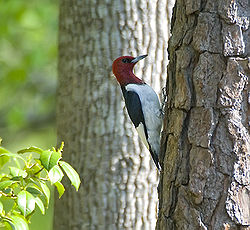Red-headed Woodpecker
| Red-headed woodpecker | |
|---|---|
 |
|
| Scientific classification | |
| Kingdom: | Animalia |
| Phylum: | Chordata |
| Class: | Aves |
| Subclass: | Neornithes |
| Infraclass: | Neognathae |
| Superorder: | Neoaves |
| Order: | Piciformes |
| Suborder: | Pici |
| Family: | Picidae |
| Subfamily: | Picinae |
| Tribe: | Dendropicini |
| Genus: | Melanerpes |
| Species: | M. erythrocephalus |
| Binomial name | |
|
Melanerpes erythrocephalus (Linnaeus, 1758) |
|
 |
|
| Red-headed woodpecker range Summer range Year-round range Wintering range | |
The red-headed woodpecker (Melanerpes erythrocephalus) is a small or medium-sized woodpecker from temperate North America. Their breeding habitat is open country across southern Canada and the eastern-central United States. The species is listed as Near Threatened by the IUCN.
The red-bellied woodpecker also has its most prominent red part of its plumage on the head, but it looks quite different in other respects.
The red-headed woodpecker was one of the many species originally described by Linnaeus in his 18th-century work Systema Naturae. The specific epithet is derived from the Ancient Greek words erythros 'red' and kephalos 'head'.
There are three subspecies recognized:
Adults are strikingly tri-colored, with a black back and tail and a red head and neck. Their underparts are mainly white. The wings are black with white secondary remiges. Adult males and females are identical in plumage. Juveniles have very similar markings, but have an all grey head. While red-bellied woodpeckers have some bright red on the backs of their necks and heads, red-headed woodpeckers have a much deeper red that covers their entire heads and necks, as well as a dramatically different overall plumage pattern.
These are mid-sized woodpeckers. Both sexes measure from 19 to 25 cm (7.5 to 9.8 in) in length, with a wingspan of 42.5 cm (16.7 in). They weigh from 56 to 97 g (2.0 to 3.4 oz) with an average of 76 g (2.7 oz). Each wing measures 12.7–15 cm (5.0–5.9 in), the tail measures 6.6–8.5 cm (2.6–3.3 in), the bill measures 2.1–3 cm (0.83–1.18 in) and the tarsus measures 1.9–2.5 cm (0.75–0.98 in). The maximum longevity in the wild is 9.9 years.
They give a tchur-tchur call or on territory.
These birds fly to catch insects in the air or on the ground, on trees or gather and store nuts. They are omnivorous, eating insects, seeds, fruits, berries, nuts, and occasionally even the eggs of other birds. About two thirds of their diet is made up of plants. They nest in a cavity in a dead tree, utility pole, or a dead part of a tree that is between 2.45 and 24.5 m (8.0 and 80.4 ft) above the ground. They lay 4 to 7 eggs in early May which are incubated for two weeks. Two broods can be raised in a single nesting season. Northern birds migrate to the southern parts of the range, with most having arrived on the breeding range by late April, and having left for winter quarters by late October; southern birds are often permanent residents.
...
Wikipedia

